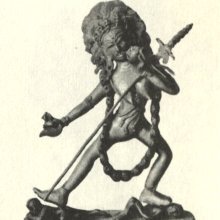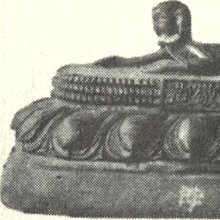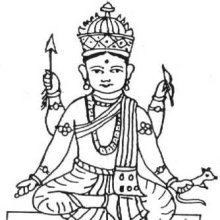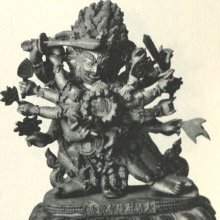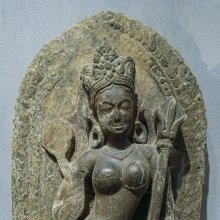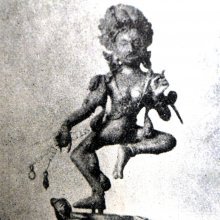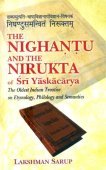Gauri, Gaurī: 36 definitions
Introduction:
Gauri means something in Buddhism, Pali, Hinduism, Sanskrit, Jainism, Prakrit, the history of ancient India, Marathi, Hindi, biology. If you want to know the exact meaning, history, etymology or English translation of this term then check out the descriptions on this page. Add your comment or reference to a book if you want to contribute to this summary article.
Images (photo gallery)
(+6 more images available)
In Hinduism
Shaktism (Shakta philosophy)
Source: Wisdom Library: Śāktism1) Gaurī (गौरी, “Shining One”):—One of the female offspring from Mahāsarasvatī (sattva-form of Mahādevī). Mahāsarasvatī is one of the three primary forms of Devī, the other two being Mahālakṣmī and Mahākālī. Not to be confused with Sarasvatī, she is a more powerful cosmic aspect (vyaṣṭi) of Devi and represents the guṇa (universal energy) named sattva. Also see the Devī Māhātmya, a Sanskrit work from the 5th century, incorporated into the Mārkaṇḍeya-Purāṇa.
2) Gaurī (गौरी):—Name of one of the sixty-four mātṛs to be worshipped during Āvaraṇapūjā (“Worship of the Circuit of Goddesses”, or “Durgā’s Retinue”), according to the Durgāpūjātattva. They should be worshipped with either the five upācāras or perfume and flowers.
Her mantra is as follows:
ॐ गौर्यै नमः
oṃ gauryai namaḥ.
3) Gauri (गौरि, “the fair one”).—One of the names of the Goddess, Devī, who is regarded as the female principle of the divine; the embodiement of the energies of the Gods.
Source: Google Books: Manthanabhairavatantram1) Gaurī (गौरी) or “white Goddess” is a name for the Goddess, according to the Manthānabhairavatantra (Kumārikākhaṇḍa), vast sprawling work that belongs to a corpus of Tantric texts concerned with the worship of the goddess Kubjikā.—The black (= dark blue) colour of the goddess is explained in the Kubjikā Tantras by her close connection to Kālī. Called Kālikā in the Kubjikāmatatantra and Bhadrakālī in the Kumārikākhaṇḍa, this is the identity of the goddess before she entered the Liṅga. Inside the Liṅga the goddess looses her dark colour and becomes the White Goddess (Gaurī). There she receives Śambhu’s empowering Command (śāmbhavājñā) by her Kaula practice, which is grounded in her blissful, spiritually aroused state.
2) Gaurī (गौरी) or “the White One” is another name for the Goddess, according to the Tantrasadbhāva chapter 10.—Accordingly, “She is called Umā and is endowed with every (form of) worldly benefit. (All) worship that goddess. She is like a mother who is always giving birth. O fair-faced one, having brought her down along with me into the midst of fettered souls (aṇu), O eternal one, she appeared in order to grace the worlds. In the sixth aeon (kalpa) (she was) Gaurī (the White One), Her colour (was) white and, beautiful, (she was) Dakṣa’s auspicious daughter. Due to Dakṣa’s insult she burnt her own body. [...]”.

Shakta (शाक्त, śākta) or Shaktism (śāktism) represents a tradition of Hinduism where the Goddess (Devi) is revered and worshipped. Shakta literature includes a range of scriptures, including various Agamas and Tantras, although its roots may be traced back to the Vedas.
Ayurveda (science of life)
Source: Wisdom Library: Āyurveda and botanyGaurī (गौरी) is another name for Tulasī, which is a Sanskrit word referring to Ocimum tenuiflorum (holy basil), from the Lamiaceae family. It is classified as a medicinal plant in the system of Āyurveda (science of Indian medicine) and is used throughout literature such as the Suśrutasaṃhita and the Carakasaṃhitā. The synonym was identified in the Rājanighaṇṭu (verses 10.148-149), which is a 13th century medicinal thesaurus.

Āyurveda (आयुर्वेद, ayurveda) is a branch of Indian science dealing with medicine, herbalism, taxology, anatomy, surgery, alchemy and related topics. Traditional practice of Āyurveda in ancient India dates back to at least the first millenium BC. Literature is commonly written in Sanskrit using various poetic metres.
Purana and Itihasa (epic history)
Source: Wisdom Library: Varāha-purāṇaGauri (गौरि).—One of the seven major rivers situated in Krauñcadvīpa, according to the Varāhapurāṇa chapter 88. It is also known by the name Puṣpavahā. Krauñcadvīpa is one of the seven islands (dvīpa), ruled over by Jyotiṣmān, one of the ten sons of Priyavrata, who is the son of Svāyambhuva Manu, who was created by Brahmā, who was in turn created by Nārāyaṇa, the unknowable all-pervasive primordial being.
The Varāhapurāṇa is categorised as a Mahāpurāṇa, and was originally composed of 24,000 metrical verses, possibly originating from before the 10th century. It is composed of two parts and Sūta is the main narrator.
Source: archive.org: Puranic Encyclopedia1) Gaurī (गौरी).—See Pārvatī.
2) Gaurī (गौरी).—A female attendant (Devī) of Pārvatī. (Vana Parva, Chapter 231, Verse 48).
3) Gaurī (गौरी).—Wife of Varuṇa. (Udyoga Parva, Chapter 117, Verse 9).
4) Gaurī (गौरी).—An Indian river. (Bhīṣma Parva, Chapter 9, Verse 25).
Source: archive.org: Nilamata Purana: a cultural and literary studyGaurī (गौरी) is the name of a Goddess that was once worshipped in ancient Kashmir (Kaśmīra) as mentioned in the Nīlamatapurāṇa.—These Goddesses (e.g., Gaurī) form the shining galaxy of female deities worshipped by the people of Kaśmīra.
Source: archive.org: Shiva Purana - English TranslationGaurī (गौरी) is another name for Pārvatī (i.e., Goddess Śivā), according to the Śivapurāṇa 2.3.8.—Accordingly, Nārada said to Himavat:—“[..] By propitating Śiva with her penance she will acquire the lustre of gold and will be known as Svarṇagaun. Your daughter will be as fair-complexioned as lightning. This girl will be famous in the name of Gaurī, She will deserve the respect of Viṣṇu, Brahmā and the other Gods. O excellent mountain, you shall not give her to anyone else. This is a secret of the gods. This shall not be revealed to any one else”.
Source: Cologne Digital Sanskrit Dictionaries: The Purana Index1a) Gaurī (गौरी).—Is Pārvatī;1 a śakti;2 the goddess enshrined at Kañya-kubja; Icon of, in a palace.3
- 1) Bhāgavata-purāṇa X. 53. 25; Brahmāṇḍa-purāṇa II. 25. 18; Vāyu-purāṇa 43. 38; 106. 58; Viṣṇu-purāṇa V. 32. 12.
- 2) Brahmāṇḍa-purāṇa IV. 44. 58.
- 3) Matsya-purāṇa 13. 29; 60. 17; 155. 30; 193. 24; 269. 54-5; 285. 7.
1b) A daughter of Antinara; the wife of Yuvanāśva; cursed by her husband, became the river Bāhudā; mother of Gaurika Māndhātṛ.*
- * Brahmāṇḍa-purāṇa III. 63. 67; Matsya-purāṇa 49. 8; Vāyu-purāṇa 88. 65-6.
1c) The wife of Virāja;1 son, Sudhāma.2
1d) A daughter of Raṇti and mother of Māndhāta.*
- * Vāyu-purāṇa 99. 130.
1e) A river in Krauñcadvīpa.*
- * Brahmāṇḍa-purāṇa II. 19. 75; Matsya-purāṇa 122. 88; Vāyu-purāṇa 49. 69; Viṣṇu-purāṇa II. 4. 55.
2) Gauri (गौरि).—Good to marry; for a son of such marriage would purify twenty-one generations of his and six on his mother's side.*
- * Vāyu-purāṇa 83. 12, 44.
Gaurī (गौरी) refers to the name of a River mentioned in the Mahābhārata (cf. VI.10.24). Note: The Mahābhārata (mentioning Gaurī) is a Sanskrit epic poem consisting of 100,000 ślokas (metrical verses) and is over 2000 years old.
Source: Shodhganga: The saurapurana - a critical studyGaurī (गौरी) refers to one of the two daughters of Himavān and Menā, according to the Vaṃśa (‘genealogical description’) of the 10th century Saurapurāṇa: one of the various Upapurāṇas depicting Śaivism.—Accordingly, Ākūti was married to Ruci and Prasūti to Dakṣa. Dakṣa produced in Prasūti twenty-four daughters. [...] [Svadhā was given to Pitṛs.] Pitṛ and Svadhā had two daughters—Menā and Dhāriṇi. Menā was given in marriage to Himavān who begot two sons—Maināka and Krauñca and two daughters—Gaurī and Gaṅgā.

The Purana (पुराण, purāṇas) refers to Sanskrit literature preserving ancient India’s vast cultural history, including historical legends, religious ceremonies, various arts and sciences. The eighteen mahapuranas total over 400,000 shlokas (metrical couplets) and date to at least several centuries BCE.
Natyashastra (theatrics and dramaturgy)
Source: Wisdom Library: SaṅgītaśiromaṇiGaurī (गौरी) refers to “the brilliant one” and is the presiding deity of gītaka (‘melodious’), according to the Saṅgītaśiromaṇi 67-84. Gītaka represents one of the sixteen words that together make up the elā musical composition (prabandha). Elā is an important subgenre of song and was regarded as an auspicious and important prabandha (composition) in ancient Indian music (gāndharva). According to nirukta analysis, the etymological meaning of elā can be explained as follows: a represents Viṣṇu, i represents Kāmadeva, la represents Lakṣmī.
Gaurī is one of the sixteen deities presiding over the corresponding sixteen words of the elā-prabandha, all of which are defined in the Saṅgītaśiromaṇi (“crest-jewel of music”): a 15th-century Sanskrit work on Indian musicology (gāndharvaśāstra).

Natyashastra (नाट्यशास्त्र, nāṭyaśāstra) refers to both the ancient Indian tradition (shastra) of performing arts, (natya—theatrics, drama, dance, music), as well as the name of a Sanskrit work dealing with these subjects. It also teaches the rules for composing Dramatic plays (nataka), construction and performance of Theater, and Poetic works (kavya).
Kavya (poetry)
Source: Shodhganga: The Kavyamimamsa of RajasekharaGaurī (गौरी) is the name of an important person (viz., an Ācārya or Kavi) mentioned in Rājaśekhara’s 10th-century Kāvyamīmāṃsā.—It is another name of Pārvati. She is wife of Lord Śiva and daughter of Himālaya, who also gave birth to Sāhitya-vidyā-vadhū.

Kavya (काव्य, kavya) refers to Sanskrit poetry, a popular ancient Indian tradition of literature. There have been many Sanskrit poets over the ages, hailing from ancient India and beyond. This topic includes mahakavya, or ‘epic poetry’ and natya, or ‘dramatic poetry’.
Chandas (prosody, study of Sanskrit metres)
Source: Shodhganga: a concise history of Sanskrit Chanda literature1) Gaurī (गौरी) is the name of a Sanskrit metre (chandas) to which Hemacandra (1088-1173 C.E.) assigned the alternative name of Pramudita-vadanā in his auto-commentary on the second chapter of the Chandonuśāsana. Hemacandra gives these alternative names for the metres by other authorities (like Bharata), even though the number of gaṇas or letters do not differ.
2) Gaurī (गौरी) refers to one of the seventy-two sama-varṇavṛtta (regular syllabo-quantitative verse) mentioned in the 334th chapter of the Agnipurāṇa. The Agnipurāṇa deals with various subjects viz. literature, poetics, grammar, architecture in its 383 chapters and deals with the entire science of prosody (e.g., the gaurī metre) in 8 chapters (328-335) in 101 verses in total.
Source: Journal of the University of Bombay Volume V: Apabhramsa metres (2)Gaurī (गौरी) refers to a type of Gāthā: one of the oldest Prakrit meters probably developed out of the epic Anuṣṭubh, as discussed in books such as the Chandonuśāsana, Kavidarpaṇa, Vṛttajātisamuccaya and Svayambhūchandas.—There are three main kinds of a Gāthā, i.e., Pathyā, Vipulā and Capalā. On the other hand, we get 26 varieties of a Gāthā if we base our division upon the number of short letters which they contain. The smallest number of short letters which a Gāthā may contain is 3 and such a Gāthā is called Kamalā; the largest number of short letters which it might contain is 55 and then it is called Gaurī.

Chandas (छन्दस्) refers to Sanskrit prosody and represents one of the six Vedangas (auxiliary disciplines belonging to the study of the Vedas). The science of prosody (chandas-shastra) focusses on the study of the poetic meters such as the commonly known twenty-six metres mentioned by Pingalas.
Pancaratra (worship of Nārāyaṇa)
Source: eScholarship: Chapters 1-14 of the Hayasirsa PancaratraGaurī (गौरी) is a name of Pārvatī, as mentioned in the 9th century Hayaśīrṣa-pañcarātra (Ādikāṇḍa chapter 1).—“[...] Formerly, it is told, Virūpākṣa-Maheśvara (i.e., Śiva) with Gaurī (i.e., Pārvatī) questioned the four-faced one (Brahmā) who was staying in the above of Vairāja”.

Pancaratra (पाञ्चरात्र, pāñcarātra) represents a tradition of Hinduism where Narayana is revered and worshipped. Closeley related to Vaishnavism, the Pancaratra literature includes various Agamas and tantras incorporating many Vaishnava philosophies.
Shilpashastra (iconography)
Source: Shodhganga: Elements of Art and Architecture in the Trtiyakhanda of the Visnudharmottarapurana (shilpa)Gaurī (गौरी) is the wife of Varuṇa, whose iconography is described in the Viṣṇudharmottarapurāṇa, an ancient Sanskrit text which (being encyclopedic in nature) deals with a variety of cultural topics such as arts, architecture, music, grammar and astronomy.—According to the Viṣṇudharmottarapurāṇa the image of Varuṇa should be made along with the image of his wife Gaurī. The image of Gaurī should be placed on the left side of her husband’s lap. She should hold a lotus in her left hand and her right hand should be placed on the back of her husband. The Kāśyapaśilpa as well as the Śilparatna do not talk about the images of Gaurī, Gaṅgā and Yamunā in connection with Varuṇa.

Shilpashastra (शिल्पशास्त्र, śilpaśāstra) represents the ancient Indian science (shastra) of creative arts (shilpa) such as sculpture, iconography and painting. Closely related to Vastushastra (architecture), they often share the same literature.
General definition (in Hinduism)
Source: Wisdom Library: HinduismGauri (गौरि, “the fair one”):—Another name for Vāruṇī, the elder of two wifes of Varuṇa, who is the presiding deity of the invisible world and represents the inner reality of things. Vāruṇī is known as the Goddess of liquor. She is also known as Gauri.
Source: WikiPedia: HinduismGaurī (गौरी): Gaurī or Dākshāyani is the Goddess of marital felicity and longevity; she is worshipped particularly by ladies to seek the long life of their husbands. An aspect of Devi, Dākshāyani is the consort of Shiva.
In Buddhism
Tibetan Buddhism (Vajrayana or tantric Buddhism)
Source: archive.org: The Indian Buddhist Iconography1) Gaurī (गौरी) refers to a group of eight Goddesses who are extremely popular in Vajrayāna and are found described in several places both in the Sadhānamālā as well as in the Niṣpannayogāvalī. These goddesses are represented also in the Chinese collection of statuettes in the city of Peiping. [...] All the deities are violent in character with fearful appearance and ornaments, and garlands of heads. They dance in pratyālīḍha and show the raised index finger with clasped fist against the chest, as the common gesture.
2) Gaurī (गौरी) refers to the first deity of the eight Gaurīs, commonly depicted in Buddhist Iconography, and mentioned in the 11th-century Niṣpannayogāvalī of Mahāpaṇḍita Abhayākara.—Her Colour is white; her Symbol is the goad; she has two arms.—The first in the series is Gaurī. Her form is described in the pañcaḍāka-maṇḍala where the Gaurī group of deities surround the principal god Vajraḍāka.
Gaurī is described in the Niṣpannayogāvalī (pañcaḍāka-maṇḍala) as follows:—
Source: academia.edu: The Structure and Meanings of the Heruka Maṇḍala“Gaurī is white and holds in her right hand the goad”.
[In the left hand she shows the tarjanī against the chest which is the common gesture.
All the deities are violent in character with fearful appearance and ornaments, and garlands of heads. They dance in pratyālīḍha and show the raised index finger with clasped fist against the chest, as the common gesture.]
Gaurī (गौरी) is also mentioned as the Ḍākinī of the eastern gate in the Jñānacakra, according to the 10th century Ḍākārṇava chapter 15. Accordingly, the jñānacakra refers to one of the three divisions of the saṃbhoga-puṭa (‘enjoyment layer’), situated in the Herukamaṇḍala. The four gate Ḍākinīs [viz., Gaurī] each has the same physical feature as the four Ḍākinīs starting with Lāmā.
Source: OSU Press: Cakrasamvara SamadhiGaurī (गौरी) refers to “white (breasts)”, according to the Cakrasaṃvara Samādhi [i.e., Cakrasamvara Meditation] ritual often performed in combination with the Cakrasaṃvara Samādhi, which refers to the primary pūjā and sādhanā practice of Newah Mahāyāna-Vajrayāna Buddhists in Nepal.—Accordingly, “In the Mandala, an obscured Himalaya, abiding seated in lotus posture, the best limb of all possessed, an equally elevated pair of white breasts (gaurī-stana-dvanda), swinging garlands, having made the gods, Upendra, Sūrya, Candra, etc., [..] a helper for crossing over together, the dreadful wilderness of saṃsāra, routing Māra, Śrī Vajrasattva, homage”.

Tibetan Buddhism includes schools such as Nyingma, Kadampa, Kagyu and Gelug. Their primary canon of literature is divided in two broad categories: The Kangyur, which consists of Buddha’s words, and the Tengyur, which includes commentaries from various sources. Esotericism and tantra techniques (vajrayāna) are collected indepently.
In Jainism
General definition (in Jainism)
Source: archive.org: The Jaina Iconography1) Gaurī (गौरी) (or Mānavī, Śrīvatsā-Devī) is the name of the Yakṣiṇī accompanying Śreyāṃśanātha: the eleventh of twenty-four Tīrthaṃkaras or Jinas, commonly depicted in Jaina iconography.—[...] This eleventh Yakṣiṇī belongs to the eleventh Tīrthaṃkara Śreyāṃśanātha. The Digambara representation of the Yakṣiṇī known therein as Gaurī rides, according to their accounts, anantelope and bears a club, lotus, urn and Varada in her hands. The Śvetāmbara variant of the same Yakṣi in the name of Mānavī or Śrīvatsā Devī has been described as riding a lion and holding a Varada club, urn and goad.
The name Gaurī originates evidently from the Brahmanic Gaurī, the wife of Śiva. Here, in this instance, the Yakṣa, of whom Gaurī is the consort is called Īśvara. Her other aspect is represented by a Vidyādevī, known by the same name. Now, the Śvetāmbaras give her the name of Śrīvatsā or Mānavī. This name, however, presents an anomaly due to the identity of Mānavī with the Digambara Yakṣiṇī, of Śītalanātha bearing the same name. Thus, it is possible to explain the name Śrīvatsā as originating from the Śrīvatsā figure, the canonical symbol of Śītalanātha. As regards the attributes, which adorn the hands of the Devī some of them are war-like, as worthy of a Yakṣiṇī, and others are benign, as symbolic of a goddess of learning.
2) Gaurī (गौरी) also refers to one of the sixteen Vidyādevīs (goddesses of learning).—Gaurī of the Śvetāmbara type rides on an alligator (godhā) and bears four hands equipped with Varada, club, rosary and water-lily. In Digambara form, too, Gaurī has an alligator as her vehicle and holds lotus as her symbol. There is also Gaurī, the Digambara Yakṣiṇī of Śreyāṃsanātha. Some of her symbols, such as lotus, Varada are identical with those of this Vidyādevī. As an alligator is mythologically associated with a form of Brahmāṇī, Gaurī or Durgā, we have reason enough to infer that the goddess, model came after her. The alligator and some of the symbols such as water-lily and urn indicate her connection with the goddess Gaṅgā of Brahmanism.
Source: archive.org: Trisastisalakapurusacaritra1) Gaurī (गौरी) is the name of a Vidyā (Mantra).—The Kalpasūtra 1.212 (cf. ‘Die Kosmographie der Inder’ p. 153a) gives the number as 48 only, but does not give the names, except of 4 mahāvidyās, Gaurī, Gāndhārī, Rohiṇī, Prajñapti.
2) Gaurī (गौरी) or Gaurīvidyā refers to one of the sixteen Vidyās from which are derived the respective classes of Vidyādharas (in this case, Gaureya), according to chapter 1.3 [ādīśvara-caritra] of Hemacandra’s 11th century Triṣaṣṭiśalākāpuruṣacaritra: an ancient Sanskrit epic poem narrating the history and legends of sixty-three illustrious persons in Jainism.
Accordingly, “[...] After making [the two rows of Vidyādhara-cities], many villages and suburbs, they established communities [viz., the Gaureyas] according to the suitability of place. [...] Dharaṇendra instructed them about the law as follows: ‘If any insolent persons show disrespect or do injury to the Jinas, or the Jinas’ shrines, or to those who will attain mokṣa in this birth, or to any ascetics engaged in pratimā, the Vidyās [viz., Gaurīs] will abandon them at once, just as wealth abandons lazy people. Whoever kills a man with his wife, or enjoys women against their will, the Vidyās will abandon him at once’.”

Jainism is an Indian religion of Dharma whose doctrine revolves around harmlessness (ahimsa) towards every living being. The two major branches (Digambara and Svetambara) of Jainism stimulate self-control (or, shramana, ‘self-reliance’) and spiritual development through a path of peace for the soul to progess to the ultimate goal.
India history and geography
Source: Cologne Digital Sanskrit Dictionaries: Indian Epigraphical GlossaryGaurī.—a virgin; cf. gaurī-varāṭikā. Note: gaurī is defined in the “Indian epigraphical glossary” as it can be found on ancient inscriptions commonly written in Sanskrit, Prakrit or Dravidian languages.

The history of India traces the identification of countries, villages, towns and other regions of India, as well as mythology, zoology, royal dynasties, rulers, tribes, local festivities and traditions and regional languages. Ancient India enjoyed religious freedom and encourages the path of Dharma, a concept common to Buddhism, Hinduism, and Jainism.
Biology (plants and animals)
Source: Google Books: CRC World Dictionary (Regional names)1) Gauri in India is the name of a plant defined with Aglaia odoratissima in various botanical sources. This page contains potential references in Ayurveda, modern medicine, and other folk traditions or local practices It has the synonym Aglaia diepenhorstii Miquel (among others).
2) Gauri is also identified with Jasminum sambac It has the synonym Mogorium gimea Zuccagni (etc.).
3) Gauri is also identified with Ocimum tenuiflorum It has the synonym Lumnitzera tenuiflora Spreng. (etc.).
4) Gauri is also identified with Polyalthia fragrans It has the synonym Guatteria fragrans Dalzell (etc.).
5) Gauri in Mali is also identified with Sorghum bicolor It has the synonym Andropogon caffrorum (Thunb.) Kunth (etc.).
6) Gauri in Senegal is also identified with Pennisetum glaucum It has the synonym Panicum compressum Balb. ex Steud. (etc.).
Example references for further research on medicinal uses or toxicity (see latin names for full list):
· Zeitschrift für Naturwissenschaften (1907)
· Systema Vegetabilium (1825)
· Systema Vegetabilium (1817)
· Bot. Žurn. (1996)
· Prodromus Florae Novae Hollandiae (1810)
· Species Plantarum (1753)
If you are looking for specific details regarding Gauri, for example chemical composition, extract dosage, diet and recipes, health benefits, side effects, pregnancy safety, have a look at these references.

This sections includes definitions from the five kingdoms of living things: Animals, Plants, Fungi, Protists and Monera. It will include both the official binomial nomenclature (scientific names usually in Latin) as well as regional spellings and variants.
Languages of India and abroad
Marathi-English dictionary
Source: DDSA: The Molesworth Marathi and English Dictionarygaurī (गौरी).—f (S) A name of pārvatī. 2 A girl prior to menstruation, a maid. 3 An unmarried girl of ten years of age. 4 The vigils and festivities in bhādrapadaśuklapakṣa in honor of pārvatī. v jāgava.
--- OR ---
gaurī (गौरी).—f (Properly gōvarī) A bit of dry cowdung. 2 A cake or pat of cowdung. 3 Crumbled cowdung.
Source: DDSA: The Aryabhusan school dictionary, Marathi-Englishgaurī (गौरी).—f A name of pārvatī. A maid. A cake of cow-dung.
Marathi is an Indo-European language having over 70 million native speakers people in (predominantly) Maharashtra India. Marathi, like many other Indo-Aryan languages, evolved from early forms of Prakrit, which itself is a subset of Sanskrit, one of the most ancient languages of the world.
Sanskrit dictionary
Source: DDSA: The practical Sanskrit-English dictionaryGaurī (गौरी).—1 Name of Pārvatī; as in गौरीनाथ (gaurīnātha).
2) A young girl eight years old; अष्टवर्षा भवेद्गौरी (aṣṭavarṣā bhavedgaurī).
3) A young girl prior to menstruation, virgin, maid; स्त्रीणां सहस्रं गौरीणाम् (strīṇāṃ sahasraṃ gaurīṇām) Mahābhārata (Bombay) 1.221.49.
4) A woman with a white or yellowish complexion.
5) The earth; गौर्यां गच्छति सुश्रोणि लोकेष्वेषा गतिः सदा (gauryāṃ gacchati suśroṇi lokeṣveṣā gatiḥ sadā) Mahābhārata (Bombay) 13.146.1.
6) Turmeric.
7) A yellow pigment or dye; (called gorocanā).
8) The wife of Varuṇa; वरुणस्य तथा गौरी (varuṇasya tathā gaurī) Mahābhārata (Bombay) 13.146.5.
9) The Mallikā creeper.
1) The Tulasī plant
11) The Manjishṭhā plant.
12) Speech.
13) Name of a Nāgakanyā. cf. ...... गौरी तु नागकन्योमयोर्मता (gaurī tu nāgakanyomayormatā) Nm.
14) Name of a river; L. D. B.
15) Night; L. D. B.
16) Name of a Rāgiṇi.
Source: Cologne Digital Sanskrit Dictionaries: Edgerton Buddhist Hybrid Sanskrit DictionaryGaurī (गौरी).—(1) name of a yoginī: Sādhanamālā 443.15; (2) name of a rākṣasī: Mahā-Māyūrī 243.17.
Source: Cologne Digital Sanskrit Dictionaries: Monier-Williams Sanskrit-English Dictionary1) Gaurī (गौरी):—[from gaura] a f. the female of the Bos Gaurus, [Ṛg-veda] (‘Vāc or voice of the middle region of the air’, [i, 164, 41] according to, [Naighaṇṭuka, commented on by Yāska i, 11] and, [Nirukta, by Yāska xi, 40])
2) [v.s. ...] = gaurikā, [Gṛhyāsaṃgraha ii, 18; Pañcatantra]
3) [v.s. ...] the earth, [cf. Lexicographers, esp. such as amarasiṃha, halāyudha, hemacandra, etc.]
4) [v.s. ...] red chalk, [Kālacakra]
5) [v.s. ...] a yellow pigment or dye (go-rocanā, ‘orpiment’ [Demetrius Galanos’s Lexiko: sanskritikes, anglikes, hellenikes]), [cf. Lexicographers, esp. such as amarasiṃha, halāyudha, hemacandra, etc.]
6) [v.s. ...] turmeric (rajanī), [Suśruta]
7) [v.s. ...] Name of several other plants (priyaṃgu, mañjiṣṭhā, śveta-dūrvā, mallikā, tulasī, suvarṇa-kadalī, ākāśa-māṃsī), [cf. Lexicographers, esp. such as amarasiṃha, halāyudha, hemacandra, etc.]
8) [v.s. ...] Name of several metres (one of 4 x 12 syllables; another of 4 x 13 syllables; another of 4 x 26 long syllables)
9) [v.s. ...] (in music) a kind of measure
10) [v.s. ...] ([ib.]) Name of a Rāgiṇī
11) [v.s. ...] ‘brilliant Goddess’, Śiva’s wife Pārvatī, [Atharva-veda.Pariś.; Nṛsiṃha-tāpanīya-upaniṣad i, 4, 3, 10 etc.]
12) [v.s. ...] Name of Varuṇa’s wife, [Mahābhārata v, xiii]
13) [v.s. ...] of a Vidyā-devī, [iii, 231, 48; Harivaṃśa]
14) [v.s. ...] of Śākya-muni’s mother, [cf. Lexicographers, esp. such as amarasiṃha, halāyudha, hemacandra, etc.]
15) [v.s. ...] of the wife of Vi-rajas and mother of Su-dhāman, [Vāyu-purāṇa i, 28, 11]
16) [v.s. ...] of several other women
17) [v.s. ...] of several rivers (one originally the wife of Prasena-jit or Yuvanāśva, changed by his curse into the river Bāhu-dā, [Harivaṃśa; Viṣṇu-purāṇa]), [Mahābhārata vi, 333; Viṣṇu-purāṇa ii, 4, 55;]
18) Gauri (गौरि):—[from gaura] in [compound] for rī q.v.
19) Gaurī (गौरी):—[from gaura] b f. of ra q.v.
Source: DDSA: Paia-sadda-mahannavo; a comprehensive Prakrit Hindi dictionary (S)Gaurī (गौरी) in the Sanskrit language is related to the Prakrit words: Gaurī, Gorī.
[Sanskrit to German]
Sanskrit, also spelled संस्कृतम् (saṃskṛtam), is an ancient language of India commonly seen as the grandmother of the Indo-European language family (even English!). Closely allied with Prakrit and Pali, Sanskrit is more exhaustive in both grammar and terms and has the most extensive collection of literature in the world, greatly surpassing its sister-languages Greek and Latin.
Hindi dictionary
Source: DDSA: A practical Hindi-English dictionaryGaurī (गौरी):—(nf) the goddess Parvati:—Shiv's spouse; ~[śaṃkara] the Mount Everest.
...
Prakrit-English dictionary
Source: DDSA: Paia-sadda-mahannavo; a comprehensive Prakrit Hindi dictionaryGaurī (गौरी) in the Prakrit language is related to the Sanskrit word: Gaurī.
Prakrit is an ancient language closely associated with both Pali and Sanskrit. Jain literature is often composed in this language or sub-dialects, such as the Agamas and their commentaries which are written in Ardhamagadhi and Maharashtri Prakrit. The earliest extant texts can be dated to as early as the 4th century BCE although core portions might be older.
Kannada-English dictionary
Source: Alar: Kannada-English corpusGauri (ಗೌರಿ):—
1) [noun] a girl in the stage prior to menstruation.
2) [noun] Pārvati, wife of Śiva.
3) [noun] a woman of white or fair complexion.
4) [noun] a bright yellow pigment prepared from the urine or bile of a cow or vomited by a cow in the form of scybala.
5) [noun] the plant Rubia cordifolia ( = R. munjista) of Rubiaceae family; Indian madder.
6) [noun] the plant Ocimum sanctum of Lamiaceae family; basil.
7) [noun] a kind of jasmine plant.
Kannada is a Dravidian language (as opposed to the Indo-European language family) mainly spoken in the southwestern region of India.
See also (Relevant definitions)
Starts with (+93): Gauri cholli, Gauri-beeja, Gauri-dhan, Gauri-varatika, Gauriballi, Gauribhartar, Gauribhartri, Gauribija, Gaurica Halava, Gauricandana, Gauricarita, Gauricaturthi, Gaurice Dohale, Gaurichaturthi, Gauridasa, Gauridashaka, Gauridatta, Gauridhava, Gauridigambara, Gauridu.
Ends with (+4): Bagu-gauri, Bhutigauri, Dandagauri, Dhurapatagauri, Garavi Sheta Gauri, Gitagauri, Gunagauri, Halavi Gauri, Haragauri, Hasatagauri, Huligauri, Jagadgauri, Kajuragauri, Mahagauri, Mangalagauri, Maunagauri, Mumgauri, Nagauri, Saubhagyagauri, Sigegauri.
Full-text (+336): Gauripati, Gauripatta, Gaurivrata, Gaurija, Gauriviti, Mulasthana, Gori, Gaurisha, Gaurilalita, Gaurivita, Gaurivara, Gauripuja, Gaurinatha, Gauriputra, Gauriguru, Gauribhartri, Gauripushpa, Vrishakapayi, Gaurikanta, Jagadgauri.
Relevant text
Search found 98 books and stories containing Gauri, Gaurī; (plurals include: Gauris, Gaurīs). You can also click to the full overview containing English textual excerpts. Below are direct links for the most relevant articles:
The Skanda Purana (by G. V. Tagare)
Chapter 185 - Greatness of Devamātṛgaurī (Devamātṛ-gaurī) < [Section 1 - Prabhāsa-kṣetra-māhātmya]
Chapter 152 - Greatness of Cakrapāṇi < [Section 1 - Tīrtha-māhātmya]
Chapter 62 - Eminence of Kaṭeśvara-Gaṅgeśvara < [Section 3 - Arbuda-khaṇḍa]
Rig Veda (translation and commentary) (by H. H. Wilson)
Cidgaganacandrika (study) (by S. Mahalakshmi)
Verse 141 [Pañca-devatākrama Sṛṣṭi] < [Chapter 3 - Third Vimarśa]
Verse 294 [Śakti not only shines in Rasmicakra but also as Bliss] < [Chapter 4 - Fourth Vimarśa]
Verse 311 [Discussion of only two aspects in Cidgaganacandrikā] < [Chapter 4 - Fourth Vimarśa]
Guhyagarbha Tantra (with Commentary) (by Gyurme Dorje)
Text 15.25 (Commentary) < [Chapter 15 (Text and Commentary)]
Text 16.3 (Commentary) < [Chapter 16 (Text and Commentary)]
Text 20.18 (Commentary) < [Chapter 20 (Text And Commentary)]
Shat-cakra-nirupana (the six bodily centres) (by Arthur Avalon)
Verses 28-29 < [Section 5]
The Agni Purana (by N. Gangadharan)
Related products
